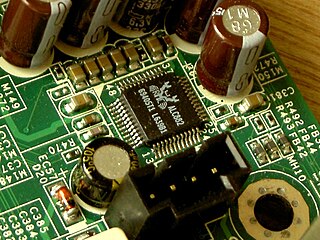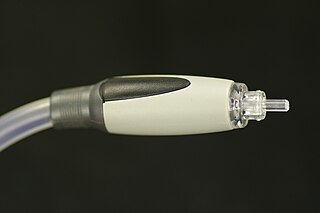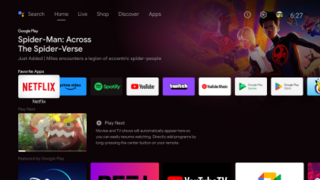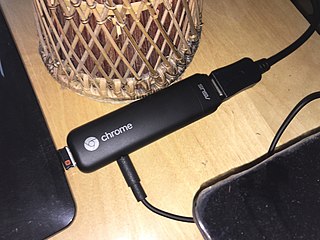Geographic availability
Electric Jukebox was available in: [18]
| Developer | The Electric Jukebox Company [1] |
|---|---|
| Type | Digital media player [2] |
| Discontinued | August 2017 |
| Sound | up to 320 kbps streaming [3] |
| Connectivity | [2] |
| Power | Mains power (HDMI Dongle) Micro-USB (Controller) [4] |
| Website | www |
Electric Jukebox was a digital media player [2] developed by The Electric Jukebox Company. [1] Designed as a dongle, [5] and a "Nintendo Wii style" [6] motion-sensitive controller with a built-in microphone for voice search, [7] The device played music audio content on a high-definition television and home audio system by directly streaming it via Wi-Fi from the Internet. [8] [9] [10] [11]
Electric Jukebox combined hardware, software, and premium music streaming access into one package; [12] Ars Technica described it as "a box with everything you need to get started in streaming music". [3]
The Electric Jukebox dongle had a HDMI plug built into the device's body. [13] The dongle was powered by mains power through an integrated power cable. Electric Jukebox ran on a Rockchip processor. The dongle contained a 3.5mm audio jack as a line out [2] to HiFi’s and speaker systems. [14]
Electric Jukebox Controller was a motion-sensitive remote control with built-in gyroscope and accelerometer to position itself in space in relation to the cursor on the TV screen. The controller also had a microphone for voice search. The controller used HDMI-CEC protocols to switch between other devices on the television without needing to use the television set's remote to change to or from Electric Jukebox. [2]
Electric Jukebox ran on a heavily modified version of the Android operating system. The front-end user interface was built in HTML5 [4] enabling OTA updates which negate users from having to perform software upgrades or app downloads normally required when using music streaming services on computers, smartphones and televisions.
Electric Jukebox's user interface incorporated neon [14] iconography and music songs and albums represented as spinning disks – a digital manifestation of a physical music product; a CD. The user interface was met with mixed reactions from commentators; several technology-focused media outlets have said the user interface is overly simple compared to other services [15] while mainstream consumer media view the simplicity of Electric Jukebox as opening up music streaming to audiences who are alienated by the complexities of music streaming. [6] CNET commented "Here's an easy way to think about Electric Jukebox: Remember when the Nintendo Wii came out, and suddenly the whole family, who didn't know their Atari from their elbow, was jumping around the living room playing video games? Spotify is the PlayStation, Sonos is the Xbox – and Electric Jukebox is the Wii." [4]
The Electric Jukebox controller's built-in microphone provided access to the full catalogue of music. Voice-activated functionality was provided by Nuance. [3]
Electric Jukebox featured exclusive playlists from a range of celebrities, including; Robbie Williams and his wife Ayda Field, [16] Sheryl Crow, Alesha Dixon and Stephen Fry. [17]
7 Digital provided a range of curated music channels for Electric Jukebox. [18]
Danish music tech company Moodagent provided music discovery and recommendations features for Electric Jukebox. [19]
Electric Jukebox users could create their own playlists using the Electric Jukebox Controller. [20]
Electric Jukebox had a music library of "over 29 million songs" [21] from all major and independent record labels and publishers including Universal Music Group, Sony Music Entertainment, Warner Music Group, Merlin, PIAS, Believe Digital and INgrooves. [22]
Electric Jukebox was available in: [18]

A home theater PC (HTPC) or media center computer is a convergent device that combines some or all the capabilities of a personal computer with a software application that focuses on video, photo, audio playback, and sometimes video recording functionality. Since the mid-2000s, other types of consumer electronics, including game consoles and dedicated media devices, have crossed over to manage video and music content. The term "media center" also refers to specialized application software designed to run on standard personal computers.

Intel High Definition Audio (IHDA) (also called HD Audio or development codename Azalia) is a specification for the audio sub-system of personal computers. It was released by Intel in 2004 as the successor to their AC'97 PC audio standard.
Various accessories for the PlayStation 3 video game console have been produced by Sony and third-party companies. These include controllers, audio and video input devices like microphones, video cameras, and cables for better sound and picture quality.

Apple TV is a digital media player and microconsole developed and marketed by Apple Inc. It is a small network appliance hardware that plays received media data such as video and audio to a television set or external display. Since its second generation model, it is an HDMI-compliant source device and can only be connected to an enhanced-definition or high-definition widescreen television through HDMI to function.

A digital media player is a type of consumer electronics device designed for the storage, playback, or viewing of digital media content. They are typically designed to be integrated into a home cinema configuration, and attached to a television and/or AV receiver.
GameCube accessories include first-party releases from Nintendo, and third-party devices, since the GameCube's launch in 2001.

TOSLINK is a standardized optical fiber connector system. Also known generically as optical audio, its most common use is in consumer audio equipment, where it carries a digital audio stream from components such as CD and DVD players, Digital Audio Tape recorders, computers, and modern video game consoles, to an AV receiver that can decode two channels of uncompressed pulse-code modulated (PCM) audio or compressed 5.1/7.1 surround sound such as Dolby Digital or DTS Surround System. Unlike HDMI, TOSLINK does not have the bandwidth to carry the uncompressed versions of Dolby TrueHD, DTS-HD Master Audio, or more than two channels of PCM audio.

A dongle is a small piece of computer hardware that connects to a port on another device to provide it with additional functionality, or enable a pass-through to such a device that adds functionality.

Nexus Q is a digital media player developed by Google. Unveiled at the Google I/O developers' conference on June 27, 2012, the device was expected to be released to the public in the United States shortly thereafter for US$300. The Nexus Q was designed to leverage Google's online media offerings, such as Google Play Music, Google Play Movies & TV, and YouTube, to provide a "shared" experience. Users could stream content from the supported services to a connected television, or speakers connected to an integrated amplifier, using their Android device and the services' respective apps as a remote control for queueing content and controlling playback.
Miracast is a standard for wireless connections from sending devices to display receivers, introduced in 2012 by the Wi-Fi Alliance. It can roughly be described as "HDMI over Wi-Fi", replacing the cable from the device to the display.
The following is a list of on-demand music streaming services. These services offer streaming of full-length content via the Internet as a part of their service, without the listener necessarily having to purchase a file for download. This type of service is somewhat similar to Internet radio. Many of these sites have advertising and offer non-free options in the style of a digital music store.

Chromecast is a line of digital media players developed by Google. The devices, designed as small dongles, can play Internet-streamed audio-visual content on a high-definition television or home audio system. The user can control playback with a mobile device or personal computer through mobile and web apps that support the Google Cast protocol, or by issuing commands via Google Assistant; later models introduced an interactive user interface and remote control. Content can be mirrored to video models from the Google Chrome web browser on a personal computer or from the screen of some Android devices.

Amazon Fire TV is a line of digital media players and microconsoles developed by Amazon. The devices are small network appliances that deliver digital audio and video content streamed via the Internet to a connected high-definition television. They also allow users to access local content and to play video games with the included remote control or another game controller, or by using a mobile app remote control on another device.

Android TV is a smart TV operating system based on Android and developed by Google for television sets, digital media players, set-top boxes, and soundbars. A successor to Google TV, it features a user interface designed around content discovery and voice search, content aggregation from various media apps and services, and integration with other recent Google technologies such as Assistant, Cast, and Knowledge Graph.
The Nexus Player was a digital media player co-developed by Google, Intel and Asus. It was the second media player in the Google Nexus family of consumer devices. Originally running the Android 5.0 ("Lollipop") operating system, it was the first device to employ the Android TV platform. The Nexus player supports Google Cast, the feature for selecting and controlling media playback on a television that was first introduced by Chromecast. Sales of the Nexus Player were discontinued in May 2016, and product support ended in March 2018.
Google TV is an online video on demand service operated by Google. The service offers movies and television shows for purchase or rental, depending on availability. The service initially launched in May 2011 as Google Movies and was later renamed Google Play Movies & TV following its integration into the Google Play digital distribution service in 2012.

The Chromebit is a stick PC running Google's ChromeOS. It is able to be plugged into any display via HDMI to act as a personal computer. Keyboards and mice are able to be connected over Bluetooth or Wi-Fi. The device was announced in April 2015 and began shipping November 2015.
EZCast is a line of digital media players, built by Actions Microelectronics, that allows users to mirror media content from smart devices, including mobile devices, personal computers, and project to high-definition televisions.

ROXi, is a television-based music entertainment experience providing full catalogue music streaming, radio, karaoke, music games, sound machine and photo visuals via a TV user interface on pay TV and Smart TV platforms and via ROXi Music System; a dedicated digital media player.